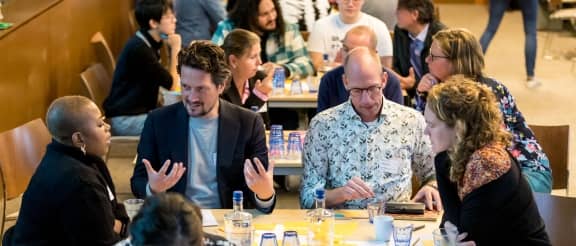Packalicious Live sparks transition to intrinsically sustainable packaging
The future of packaging needs to be discussed urgently today. All participants at Packalicious Live agreed on that. A diverse group of 60 brand owners, retailers, packaging suppliers, universities and students came together in Soesterberg on 9 November for inspiration and to discuss innovative packaging solutions at system level. How can they jointly map out the way towards intrinsically sustainable packaging?

Chairperson Tieneke Breemhaar opened the day with this question to KIDV's managing director Chris Bruijnes. KIDV is co-founder of Packalicious. Bruijnes: "First of all, we have to realise that recycling is only part of the solution. We currently spend a lot of time on making packaging more recyclable, but we also need to look further in order to make the packaging chain circular. In fact, to close loops completely, we need to go one step further. That is intrinsically sustainable packaging, or in two words: no harm. Packaging without harming people and the environment. As to what that exactly looks like, we don't have an answer to at the moment. So this is exactly the challenge of Packalicious: how can we find future-proof solutions for this?"
In Packalicious - the learning community in sustainable packaging - various parties have been working for some time to promote 'new thinking about packaging'. Last year, two pilots worked on two different issues; now it is time to take the community to the next level. A characteristic feature is the interdisciplinary approach: the Packalicious Pioneers look at current issues from all kinds of different angles, provided by the participating companies.
Bjorn de Koeijer (University of Twente) stood at the forefront of Packalicious and explained the purpose of the day on stage. "We believe in joining forces. To ultimately achieve radical change, we need to find and ask the right questions today. This will be the input for the upcoming sessions and the continuation of Packalicious."
To spark the creativity of participants, former environment minister Jacqueline Cramer presented the ten guiding principles of the circular economy. "My main message is: we cannot only look to the government to get a circular economy done," said Cramer, now a professor at Utrecht University and also chairman of the KIDV's Board of Independent Experts. "The more forcefully the government sets goals and deploys policy instruments, the better. But in parallel, front-runner groups and learning communities such as Packalicious are of great importance. After all, it all starts with a coalition of people who really see the need to change, have high ambitions and also see opportunities to make radical changes."
"They can collectively demonstrate how the innovation can scale up and eventually become mainstream. This is a difficult process and a big adventure, because nobody knows exactly how to do it. So it is important to learn together. As long as everyone in the coalition of the willing is willing to participate and has a clear vision of where it should go, big leaps can be made."
Click here for Jacqueline Cramer's presentation.

The next part of the packed programme was a variety of knowledge sessions, in which various knowledge institutions presented research results and a number of companies presented their ambitions, motivations and challenges:
- Rethink in the value chain - Stefan Hermsen (HAS Green Academy) and Inge Oskam (Amsterdam University of Applied Sciences)
- Contribute to a world without waste - Lotte Mastwijk (LC Packaging)
- Consumer behaviour - Ellen van der Werff (University of Groningen)
- A brand owner's view on sustainability transitions: balancing solutions - Patrick van Baal (FrieslandCampina)
- Weathering the perfect storm - Microplastics and additives - Arturo Castillo (Copernicus Institute of Sustainable Development, Utrecht University)
- From personal care to good care - Sjoerd Trompetter (Naïf Care)
After these knowledge sessions, the participants had to get to work themselves. Three parallel brainstorming sessions respectively addressed the future of shopping, the future of on-the-go consumption and the future of bulk transportation. The case studies for these came from Albert Heijn, KraftHeinz and LC Packaging. During the brainstorming session, future scenarios were further elaborated, but especially the way to get there. There was a lot of out-of-the-box thinking from the various disciplines and eventually one route was chosen and presented in plenary.
Afterwards, the audience reacted enthusiastically. Nick Schallies (Action): "This interaction and communication is extremely important in the steps we want to take together. Today was a good start to get to know each other better. In addition, a lot of creativity emerged in the group. The task is now up to us collectively to start making all these ideas concrete."
Petra Veen, learning advisor at the KIDV, fully agrees. "Several groundbreaking innovations have been discussed. These views about the future of intrinsically sustainable packaging serve as the basis for research and experiments in the continuation of Packalicious. With the aim of generating realistic solutions to complex and current packaging issues. That is what we are going to work on!"
Want to see more about this event and its outcomes? Click here for a visualisation of the day. Photos can be found here.
Want to know more about Packalicious? Click here. The next session will be held on 22 March 2023.
